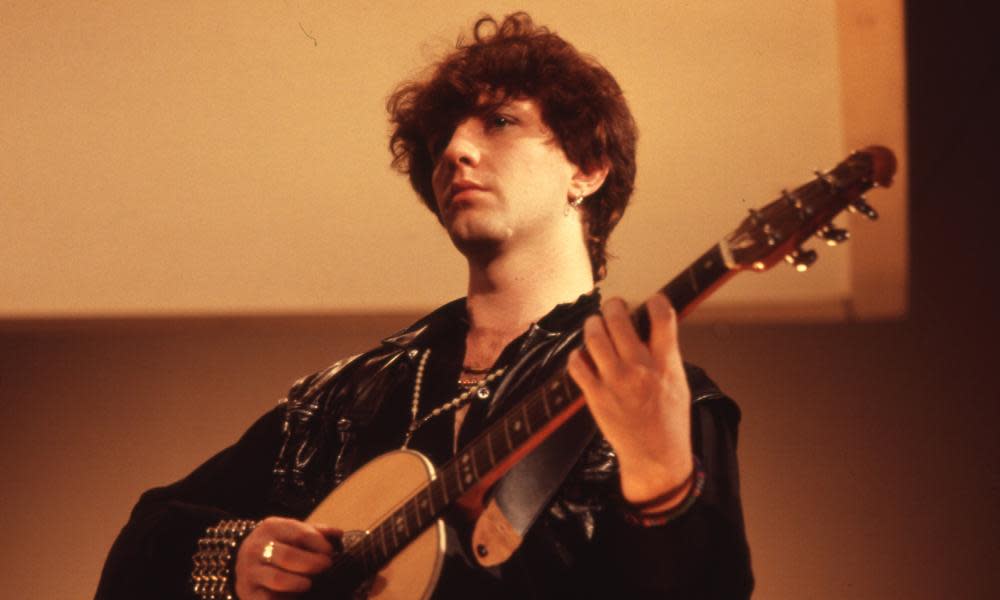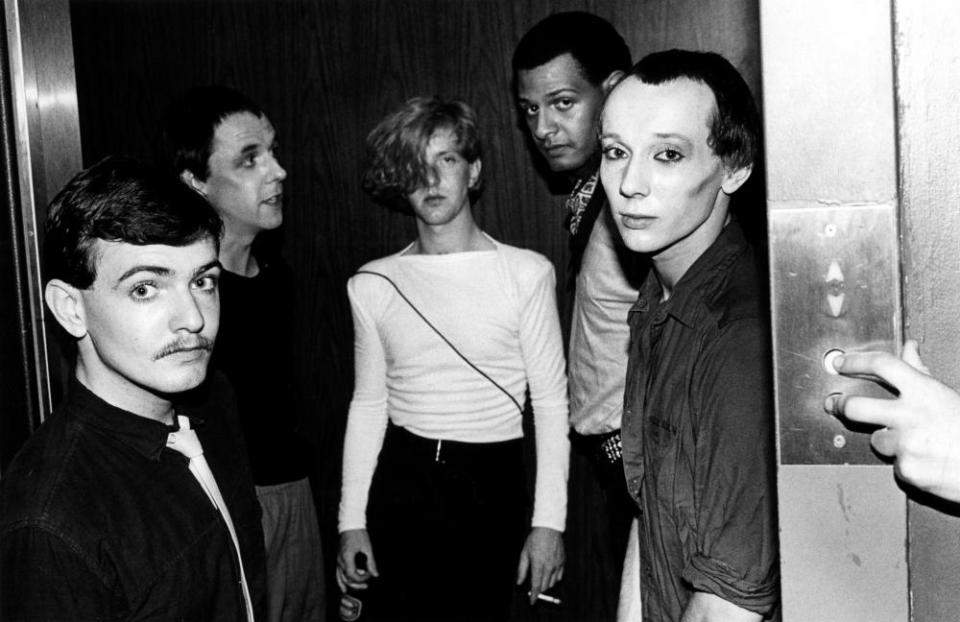‘Invention, grace and bloodlust ballet’: post-punk guitarist John McGeoch

McGeoch sent a jolt through the scene with Magazine, Siouxsie Sioux and more. Johnny Marr, James Dean Bradfield and others salute an overlooked musician
Manchester, 1976, in a flat above a fish shop that reeked so badly even thieves wouldn’t approach it, John McGeoch obsessively hammered away at his guitar. When the electricity meter ran out he would play for hours unamplified in complete darkness.
McGeoch was a Scottish fine art student and when his flatmate Malcolm Garrett (who would design artwork for Buzzcocks, Duran Duran and Simple Minds) told Howard Devoto, who’d recently quit punk pioneers Buzzcocks, that McGeoch could play all the parts of Television’s Marquee Moon, Devoto was impressed. “That made me think he would be somebody worth knowing,” he recalls in The Light Pours Out of Me, a new biography on McGeoch by Rory Sullivan-Burke.
The pair connected and this materialised into Magazine and their revelatory debut single Shot By Both Sides. Despite the riff being a hand-me-down from Buzzcocks, McGeoch’s playing on it – as urgent and taut as it was fluid and melodic – quickly grabbed people. Siouxsie Sioux recalled: “everyone was saying: ‘who is playing guitar in Magazine?’”
It captivated a teenage Johnny Marr. “Shot By Both Sides was so arresting,” he tells me. “The sound and attitude was very modern – it sounded like it had an agenda.” The track was a line in the sand for Marr. “Punk wasn’t the letter A in a new alphabet, it was Z in the old lexicon and then after was a clean slate.”

McGeoch was operating at an elevated level for the times, according to Marr. “He took that artistic big bang [punk] into something so much more than just barre chord thrash,” he says. “He wasn’t pretending to be in some crap spitting punk band. He wasn’t joining in the dumbing down brigade. His intention was to be modern and you hear that in the very deliberate choice of using the flanger on everything.”
The flanger – normally a foot pedal, used to bend the notes of a guitar – was customised by McGeoch. He adapted it to be attached to a mic stand and controlled by hand, allowing greater control and resulting in a ringing, icy sound that had both cinematic scope and a fierce crunch. “John’s playing was a deliberate modernism,” says Marr. “The flanger modulates the signal so that it wobbles, and the effect is psychedelic. Not ‘oh so trippy 60s man’ or Hendrix, but psychedelic like you’ve taken bad acid or been psychotic after three days of speed.”
Across three albums – Real Life, Secondhand Daylight and The Correct Use of Soap – McGeoch’s playing was an electric presence. “I had the fortune to watch him execute his talent in the most incredibly dexterous way,” recalls Magazine’s Barry Adamson. “He seemed to be able to take on anything that came to his mind. I didn’t see him struggle.”
McGeoch was a versatile player, gliding between sparkling arpeggios, ripping riffs, or simply adding subtle colour, balancing deftness and potency. “John’s playing helped shape the new wave musical landscape by finding a new place for guitar,” says James Dean Bradfield of the Manic Street Preachers. “Its place became less vainglorious, less heroic perhaps, but still strident, articulate and aggressive when it needed to be.”
The Correct Use of Soap was deemed a masterpiece by many, including Marr. It obsessed a 10-year-old Jonny Greenwood who played it on repeat and took notes, but McGeoch was frustrated by the band’s lack of commercial success. McGeoch, Adamson and Magazine keyboard player Dave Formula were poached to play in Visage, who quickly had huge success, providing McGeoch with financial stability as well as a taste for fine wine.
But there was another band who wanted him: Siouxsie and the Banshees. They had just lost their guitarist and drummer and while still with Magazine he was invited to play on Happy House, immediately making an impact with a shimmering guitar line that snakes through the song. He was eventually convinced to make the switch permanent in 1980. “The Banshees were his mistress and eventually we got him to leave his wife,” Steven Severin of the band says. “It was like getting George Best on guitar,” says Marr.
“There was a huge gaping hole [in Magazine] as soon as he left,” says Adamson. “It changed the course of the band forever and helped it to its place of ultimate derailment.” Magazine were over a year later.
The albums Kaleidoscope, Juju and A Kiss in the Dreamhouse marked a hugely fertile period for the Banshees with McGeoch-powered tracks such as Spellbound invoking “pure invention, grace and bloodlust ballet” according to Bradfield. Marr adds: “The music he made with the Banshees … the word imperial was made for that music.”

However, despite the creative peaks, McGeoch’s thirst for booze – which was already plentiful – was increasing, and cocaine was thrown into the mix. Things imploded in 1982 in Madrid when McGeoch was in such bad shape he was playing the wrong songs on stage. “It became obvious that he didn’t know where he was,” Banshees drummer Budgie later said. “I thought he’d just gone too far that night, but much later he admitted that he’d been given a Valium to calm his nerves, cos he was shaking either from withdrawal or too much drinking. If we’d been noticing this we might have said the show can’t go on. But we weren’t.”
McGeoch ended up in addiction clinic the Priory but was fired by the band after they visited him and instead of being in hospital he’d gone to the pub with the day release patients. “It sounds very callous,” Sioux has said of the move. “I wish it hadn’t happened. But alcoholism is not something that gets fixed overnight.” Severin reflects on the decision: “40 years ago the term rehab was not used yet; there were no support systems available, especially in the music industry. For all we knew John was effectively committed to an asylum until further notice.”
McGeoch then joined the Armoury Show with ex-Magazine drummer John Doyle and ex-Skids members Richard Jobson and Russell Webb. However, yet another iconic post-punk band wanted him: Public Image Ltd.
He lasted six years but it wasn’t an auspicious start. Early on his first tour in Austria a rowdy crowd, still acting out the cartoon version of punk, were spitting and throwing things. McGeoch confronted them and in return got a 1.5 litre wine bottle – stolen from PiL’s dressing room – launched into his face. This resulted in laser surgery and 44 stitches; bandmates think he lost about a pint of blood before he could even get off stage.
It wasn’t the first time McGeoch had intervened in the audience’s idiotic parroting of punk’s heyday, once climbing into the crowd at a Banshees show to rip off a Nazi armband. The wine bottle incident rocked him, though, and people noticed a distinct change in him.
PiL came to an end when Lydon accepted a solo deal. McGeoch was a martial arts expert and when he was told by the band’s manager there was no new album deal and PiL was effectively over, he later told a friend that he contemplated taking him out to the pub car park and killing him. Instead, he walked away.
He tried to get a band off the ground with Heaven 17’s Glenn Gregory but it never happened and he retreated from music, focused on family life and trained as a nurse. He returned to music later on, writing theme tunes for Channel 5, but at just 48 he died of Sudep (sudden unexpected death in epilepsy). Alcohol had remained a major problem but he was sober in the final months of his life.
“John’s approach to playing helped define an entire genre of music that came after punk,” says his biographer Sullivan-Burke. The simplicity of his playing, combined with a technical ability that never veered into needless virtuosity, inspired many from 1990s American grunge and alt-rock to British pop. “He chose very simple lines over anything bombastic,” Roddy Frame of Aztec Camera once said. “He was kind of a guitar antihero, the song came first and he tried to complement that.”
Steve Albini emulated some of his playing in his pulverising noise rock band Big Black. “He was an innovator with the pure sound of his guitar,” he tells me. “I admire the economy of his playing. He made very precise choices that were usually beautifully simple.” He also shaped one of the Manic Street Preachers’ most beloved records. “John was a massive influence on The Holy Bible,” says Bradfield. “Being a fan of Magazine and the Banshees prepared me so well for that album without really realising it at the time.”
After his death Sioux reflected on his talent and impact in the Banshees. “John McGeoch was my favourite guitarist of all time,” she said. “He was into sound in an almost abstract way. I loved the fact that I could say, ‘I want this to sound like a horse falling off a cliff’, and he would know exactly what I meant. He was easily, without a shadow of a doubt, the most creative guitarist the Banshees ever had.”
• The Light Pours Out of Me by Rory Sullivan-Burke is out now, published by Omnibus Press

 Yahoo News
Yahoo News 
